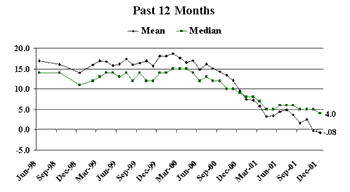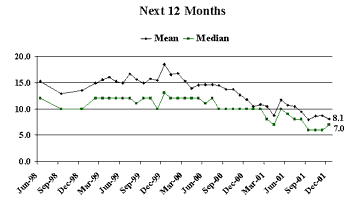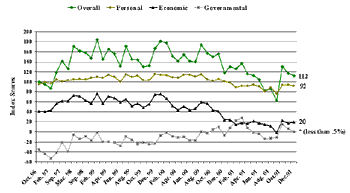GALLUP NEWS SERVICE
PRINCETON, NJ -- Over the past several years, investors have had very optimistic expectations for their portfolios' rate-of-return. In fact, when Gallup has asked investors for their expectations, the rates-of-return anticipated by investors averaged in the double-digits in each of the past three years (Dec. 1998, Dec. 1999, and Dec. 2000). Investor exuberance was particularly telling in December 1999, when investors suggested that they expected to receive an average rate-of-return on their portfolios of 18.4% in 2000.
Of course, sometimes investors can get carried away when they are having a good experience and are being interviewed about it. Further, when everyone is saying that their investments are doing extremely well, some investors may get overly enthusiastic. This applies to investor assessments of their past successes, as well as their expectations for the future of their current investments.
In this regard, it is much more important to look at the trend in investor rates-of-return, whether they are past or future, than it is to look at absolute levels. And, in this context, 2001 was clearly a very bad year for most investors. Of course, this is not news.
On the other hand, in spite of plummeting investment returns, the events of 9/11, and the continuing recession, investors are optimistic that they will get much better rates-of-return in 2002. Two out of three (69%) investors continue to say that now is a good time to invest. These are clearly positive signs for the future of the U.S. economy.
Rates of Return Plunged Last Year
In December 1998, American investors reported that their portfolios had given them, on average, a 14% rate-of-return over the previous 12 months. Half said that they had an 11% or greater rate-of-return on their investments. By December 1999, investors were reporting an even greater 18.1% rate-of-return, on average, for the year.
Things changed dramatically just one year later, as investors reported that their average rate-of-return was 9.5% in December 2000 -- only half what it had been a year earlier. Still, not a bad rate-of-return by the standards of most years.
In December 2001, however, investors reported that they had essentially no return on their investments for the year, as they reported an average rate-of-return of -0.8%. Half of all American investors said that their portfolios had an average return of 4% or less for the year 2001 -- indicating that some investors obviously had much greater losses than others in 2001. Obviously, 2001 was not a year most investors will want to remember.
| Overall Percentage Rate-of-Return on
Portfolio June 1998 to December 2001 |
 |
But, Investors Look for Better Returns This Year
As investors look forward to 2002, they expect to get much better rates-of-return than they did last. On average, they expect to obtain an 8.1% average return on their portfolios over the next 12 months. Clearly, this is fairly optimistic, when compared to the fact that they got virtually no return from their investments last year.
On the other hand, it is lower than they expected last year at this time. In December 2000, investors said they expected 2001 to bring a rate-of-return on their portfolios averaging 11.8%. Obviously, such good expectations only enhanced the pain of the non-existent returns most investors experienced last year.
Further, investors' expectations for 2002 are much lower than they have been in recent years. In December 1999, investors said they expected an average 18.1% rate-of-return in 2000. In December 1998, investors voiced expectations of a 13.5% rate-of-return in 1999.
| Overall Percentage Rate-of-Return on
Portfolio June 1998 to December 2001 |
 |
Most Investors Say It Is a Good Time to Invest
For most of the past several years, two-thirds or more of American investors have said that it is a good time to invest. Neither the events of 9/11 nor the non-existent investment returns of 2001 have changed that strongly held investor position. In December 2001, more than two out of three (69%) investors said that it is a good time to invest.
| Good Time To Invest June 1998 to December 2001 |
 |
Still, Investor Optimism Remains Subdued
While investors are optimistic that 2002 will yield better returns than last year, their overall optimism remains at comparatively low levels. In December, the UBS/Gallup Index of Investor Optimism fell a modest 112 from 117. The decline in the Index is due to a 17-point drop in optimism among "Substantial Investors" -- those having more than $100,000 of investable assets. The Substantial Investor Index dropped from 153 in November to 136 in December. Importantly, the trend in optimism among substantial investors has been relatively more indicative of future economic activity.
The Index of Investor Optimism is comprised of three dimensions: a personal dimension, an economic dimension, and a governmental dimension. In December, the personal dimension was at 92 -- 2 points below last month's level, and 9 points below the 101 of December 2000. On the other hand, the economic dimension was at 20 in December -- 3 points above its November level, but only half the level it was at just 13 months ago -- 41 in November 2000.
| The Index of Investor Optimism --
U.S. October 1996 to December 2001 |
 |
While investor optimism has clearly recovered from its sharp September plunge, it remains relatively weak. Most significantly, substantial investor optimism is going in the wrong direction as the year 2001 comes to a close.
Survey Methods
Results for the Gallup/UBS PaineWebber "Index of Investor Optimism" Poll are based on telephone interviews with a randomly selected national sample of 1,004 adult investors, 18 years and older, with at least $10,000 of investable assets, conducted December 1-17, 2001. For results based on this sample, one can say with 95 percent confidence that the maximum error attributable to sampling and other random effects is plus or minus 3 percentage points.
In addition to sampling error, question wording and practical difficulties in conducting surveys can introduce error or bias into the findings of public opinion polls.
